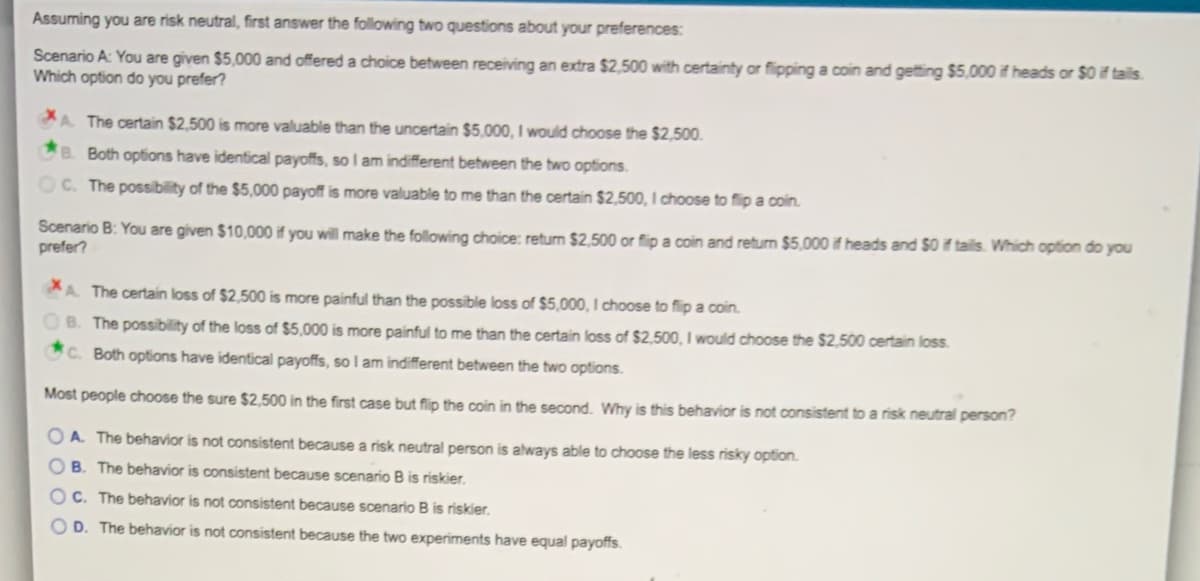Assuming you are risk neutral, first answer the following two questions about your preferences: Scenario A: You are given $5,000 and offered a choice between receiving an extra $2,500 with certainty or fipping a coin and getting $5,000 f heads or $O if tails. Which option do you prefer? A The certain $2,500 is more valuable than the uncertain $5,000, I would choose the $2,500. B. Both options have identical payoffs, so I am indifferent between the two options. OC. The possibility of the $5,000 payoff is more valuable to me than the certain $2,500, I choose to flip a coin. Scenario B: You are given $10,000 if you will make the following choice: returm $2.500 or flip a coin and return $5.000 if heads and so f tails. Which option do you prefer?
Assuming you are risk neutral, first answer the following two questions about your preferences: Scenario A: You are given $5,000 and offered a choice between receiving an extra $2,500 with certainty or fipping a coin and getting $5,000 f heads or $O if tails. Which option do you prefer? A The certain $2,500 is more valuable than the uncertain $5,000, I would choose the $2,500. B. Both options have identical payoffs, so I am indifferent between the two options. OC. The possibility of the $5,000 payoff is more valuable to me than the certain $2,500, I choose to flip a coin. Scenario B: You are given $10,000 if you will make the following choice: returm $2.500 or flip a coin and return $5.000 if heads and so f tails. Which option do you prefer?
Essentials of Business Analytics (MindTap Course List)
2nd Edition
ISBN:9781305627734
Author:Jeffrey D. Camm, James J. Cochran, Michael J. Fry, Jeffrey W. Ohlmann, David R. Anderson
Publisher:Jeffrey D. Camm, James J. Cochran, Michael J. Fry, Jeffrey W. Ohlmann, David R. Anderson
Chapter15: Decision Analysis
Section: Chapter Questions
Problem 19P: A firm has three investment alternatives. Payoffs are in thousands of dollars. a. Using the expected...
Related questions
Concept explainers
Risk and return
Before understanding the concept of Risk and Return in Financial Management, understanding the two-concept Risk and return individually is necessary.
Capital Asset Pricing Model
Capital asset pricing model, also known as CAPM, shows the relationship between the expected return of the investment and the market at risk. This concept is basically used particularly in the case of stocks or shares. It is also used across finance for pricing assets that have higher risk identity and for evaluating the expected returns for the assets given the risk of those assets and also the cost of capital.
Question
Please solve the last one

Transcribed Image Text:Assuming you are risk neutral, first answer the following two questions about your preferences:
Scenario A: You are given $5,000 and offered a choice between receiving an extra $2,500 with certainty or flipping a coin and getting $5,000 if heads or $0 if tails.
Which option do you prefer?
A The certain $2,500 is more valuable than the uncertain $5,000, I would choose the $2,500.
B. Both options have identical payoffs, so I am indifferent between the two options.
OC. The possibility of the $5,000 payoff is more valuable to me than the certain $2,500, I choose to fip a coin.
Scenario B: You are given $10,000 if you will make the following choice: return $2,500 or flip a coin and return $5,000 if heads and $0 if tails. Which option do you
prefer?
A The certain loss of $2,500 is more painful than the possible loss of $5,000, I choose to flip a coin.
B. The possibility of the loss of $5,000 is more painful to me than the certain loss of $2,500, I would choose the $2,500 certain loss.
C. Both options have identical payoffs, so I am indifferent between the two options.
Most people choose the sure $2,500 in the first case but flip the coin in the second. Why is this behavior is not consistent to a risk neutral person?
O A. The behavior is not consistent because a risk neutral person is always able to choose the less risky option.
B. The behavior is consistent because scenario B is riskier.
C. The behavior is not consistent because scenario B is riskier.
O D. The behavior is not consistent because the two experiments have equal payoffs.
Expert Solution
This question has been solved!
Explore an expertly crafted, step-by-step solution for a thorough understanding of key concepts.
This is a popular solution!
Trending now
This is a popular solution!
Step by step
Solved in 2 steps

Knowledge Booster
Learn more about
Need a deep-dive on the concept behind this application? Look no further. Learn more about this topic, finance and related others by exploring similar questions and additional content below.Recommended textbooks for you

Essentials of Business Analytics (MindTap Course …
Statistics
ISBN:
9781305627734
Author:
Jeffrey D. Camm, James J. Cochran, Michael J. Fry, Jeffrey W. Ohlmann, David R. Anderson
Publisher:
Cengage Learning


Individual Income Taxes
Accounting
ISBN:
9780357109731
Author:
Hoffman
Publisher:
CENGAGE LEARNING - CONSIGNMENT

Essentials of Business Analytics (MindTap Course …
Statistics
ISBN:
9781305627734
Author:
Jeffrey D. Camm, James J. Cochran, Michael J. Fry, Jeffrey W. Ohlmann, David R. Anderson
Publisher:
Cengage Learning


Individual Income Taxes
Accounting
ISBN:
9780357109731
Author:
Hoffman
Publisher:
CENGAGE LEARNING - CONSIGNMENT